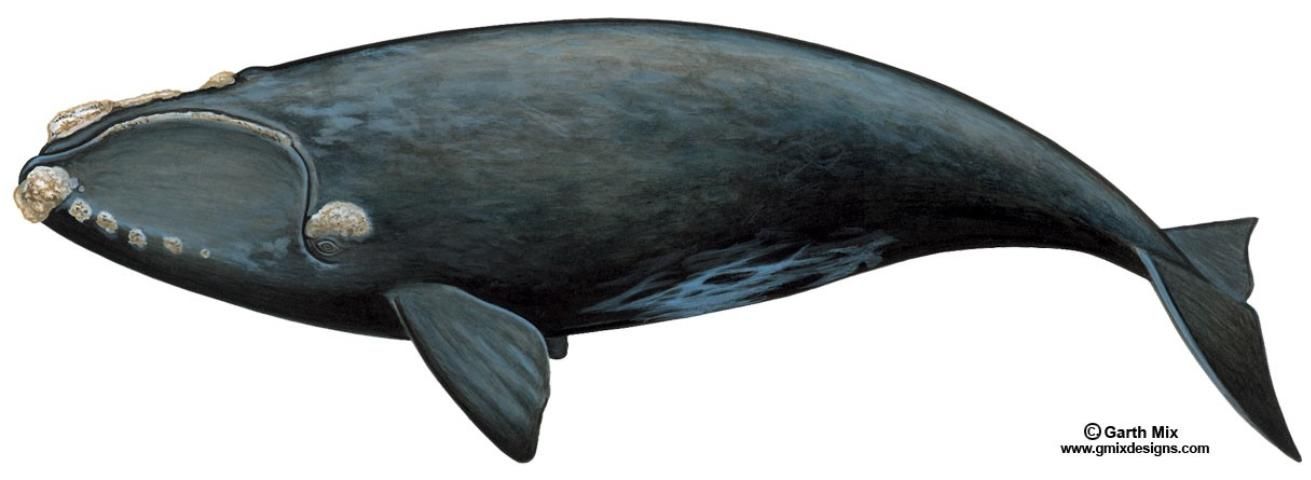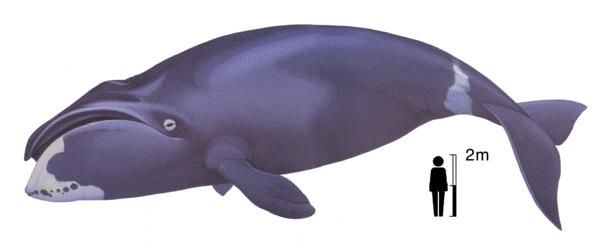Description
Students will use Greek and Latin root words to interpret the scientific names of some whales.
Objectives
By the conclusion of the activities, students will:
- Be able to explain basic scientific naming practices that pertain to naming plants and animals
- Be able to properly write and capitalize a scientific name
- Be able to explain the scientific name for at least one common whale or dolphin
- Be able to use Greek and Latin roots to create a scientific name (genus and species) that describes a fictional cetacean that they have created
What You Will Need
- Copies of the Greek and Latin word fragment sheet for each student (page 5-5; for Parts 1 and 2)
- Whiteboard or overhead projector and markers (for Part 1)
- Printed copies of the whale images (pages 5-6 to 5-9) to hand out to students or a single copy of the images to project using an overhead projector (for Part 1)
- Art supplies as desired (pencils, paper, paints, newspaper, glue, clay, etc.) (for Part 2)
- Copies of Cetacean Information sheet (pages 5-10 to 5-11) for all students (for Part 2)
Standards
Florida Sunshine State Standards
English Language Arts
- ELA.4.V.1.1 Use grade-level academic vocabulary appropriately in speaking and writing.
- ELA.4.1V.1.2 Apply knowledge of common Greek and Latin roots, base words, and affixes to determine the meaning of unfamiliar words in grade-level context.
Visual Art
- VA.4.F.1.1 Combine art media with innovative ideas and techniques to create two- and/or three-dimensional works of art.
- VA.4.S.3.2 Plan and produce art through ongoing practice of skills and techniques.
Common Core Standards
ELA/Literacy
- RF.4.3 Know and apply grade-level phonics and word analysis skills in decoding words.
- W.4.3 Write narratives to develop real or imagined experiences or events using effective technique, descriptive details, and clear event sequences.
- W.4.4 Produce clear and coherent writing in which the development and organization are appropriate to task, purpose, and audience.
- L.4.1 Demonstrate command of the conventions of standard English grammar and usage when writing or speaking.
- L.4.2 Demonstrate command of the conventions of standard English capitalization, punctuation, and spelling when writing.
- L.4.3 Use knowledge of language and its conventions when writing, speaking, reading, or listening.
- L.4.6 Acquire and use accurately grade-appropriate general academic and domain-specific words and phrases, including those that signal precise actions, emotions, or states of being (e.g., quizzed, whined, stammered) and that are basic to a particular topic (e.g., wildlife, conservation, and endangered when discussing animal preservation).
Strategy
Part 1: Learning about Scientific Names
- Explain that every plant and animal has its own scientific name. Scientists around the world recognize this name, regardless of which language they speak. The scientific name has two parts to it. The first part is the genus name, which is always capitalized. The second part is the species name, which is always written in lower case. Organisms that share the same genus name are closely related. Organisms with similar species names may share common features, such as shape or color. The species name usually describes something about the organism, the person who discovered the organism, or the location where the organism was first observed. The scientific name is usually made up of words that come from either Latin or Ancient Greek.
- Distribute copies of the Greek and Latin word fragment sheet. Point out that the word fragments that have a hyphen at the beginning are suffixes. Those that have a hyphen at the end are prefixes. The words are sometimes used by themselves, or with a suffix or prefix.
- Explain that the scientific name for the North Atlantic right whale is Eubalaena glacialis (you-buh-LEE-nuh glay-see-AL-liss). Write this name on the board. Explain to the students that these words come from one Greek word and two Latin words (also referred to as "roots"). Have the students look on the sheet for the words (eu, balaena, and glacialis) and ask them what each one means.
a. eu = true
b. balaena = whale
c. glacialis = frozen
So, a literal translation of this name would be "frozen true whale" (probably because it can be found in very cold waters).
4. Explain that the scientific name for the short-finned pilot whale is Globicephala macrorhynchus (GLOW-bih-SEF-al-lah MA-cro-rink-us). Write this name on the board. Show the students that these words come from three Greek roots and one Latin root. Have the students look on the sheet for the words (glob, cephal, macro, and rhynch) and ask them what each one means.
a. glob = globe, ball
b. cephal = head
c. macro = large
d. rhynch = beak, snout
So, a literal translation of this name would be "large snout ball head." Show students a picture of a short-finned pilot whale (page 5-5) and explain how the scientific name is a good descriptor for this whale (it has a ball-shaped head and a large beak).
5. Ask the students to use the list of Greek and Latin word fragments to help decipher the following scientific names. Show them images of the whales.
a. Balaena mysticetus (bay-LEEN-uh miss-tih-SEE-tuss): bowhead whale [whale mustache whale]
b. Balaenoptera musculus (bay-leen-OP-ter-rah MUSK-you-luss): blue whale [muscle/muscular winged whale]
c. Tursiops truncatus (TUR-see-ops trunk-AH-tuss): bottlenose dolphin [porpoise appearance provided with a trunk]
d. Ziphius cavirostris (ZIFF-ee-us cah-vee-OSS-triss): Cuvier's beaked whale [hollow daughter of snout sword]
Part 2: Create an Imaginary Cetacean!
- Distribute the Greek and Latin word fragments and meanings sheet.
- Explain to students that they are going to invent and produce a model of an imaginary cetacean, and that they will be using the word fragments to create a scientific name that describes their whale or dolphin.
- Encourage students to create the scientific name first. Remind them that there are two parts to the scientific name, and that each part can contain a single word fragment or two or more word fragments in combination. The first word (genus) should begin with a capital letter; the second word (species) should begin with a lowercase letter. The scientific name should be italicized or underlined.
- Once the students have created a scientific name, they should draw or use other artistic media (sculpting, papier-mâché, painting, etc.) to create a picture or model of their cetacean. They should write the scientific name of their whale (along with the translation) on their picture or create a label for their model.
- Distribute Cetacean Information sheets to students. Have students pretend they are marine biologists who have discovered the cetaceans in step 2. Encourage students to be creative when filling out the imaginary information on this sheet. Students will use this information as the basis for a newspaper article describing the discovery of their cetacean and providing information about its life history.
Greek and Latin Words, Word Fragments, and Meanings
a-: no, lacking, none (Latin)
-aceous: of, or pertaining to (Latin)
-al: having the character of (Latin)
albus: white (Latin)
anglic: English (Latin)
-atus: provided with (Latin)
australis: southern (Latin)
balaena: whale (Latin)
barb: beard (Latin)
borealis: northern (Latin)
brevis: short (Latin)
caeruleus: blue (Latin)
cavus: hollow (Latin)
cephal: head (Greek)
cer: horn (Greek)
cet: whale, sea monster (Greek)
crass: thick, heavy (Latin)
delphin: dolphin (Greek)
dent: tooth (Latin)
derm: skin (Latin)
-ella: suffix added to noun stem to indicate "small" (Latin)
eu: true (Greek)
fero: to bear (Latin)
glacialis: frozen (Latin)
glob: globe, ball (Latin)
grav: heavy (Latin)
halo: sea, salt (Latin)
-inus: like (Greek)
-ic: added to nouns to form adjectives (Latin)
leuc-; leucos: white (Greek)
lineatus: lined or striped (Latin)
lip: fat (Latin)
long: long (Latin)
macro: large (Latin)
maculatus: spotted (Latin)
mauro-: dark or black (Greek)
meg: great (Greek)
mela: black; dark (Latin)
mono-: single (Greek)
musculus: muscle (Latin)
myst: mustache (Greek)
nas: nose (Latin)
nov: new (Latin)
obscurus: dark (Latin)
ocul: eye (Latin)
odon: tooth (Greek)
-oides: like (Greek)
oo-: egg (Latin)
-ops; -opsis: appearance (Greek)
orca: great killer (Latin)
orcinus: belonging to the underworld (Latin)
oscu-: mouth (Latin)
pachy-: thick (Greek)
phocaen: porpoise (Greek)
-phore: bearer (Latin)
physeter: blower (Greek)
platy-: flat or broad (Greek)
pseud: false (Greek)
pter: having wings or fins (Latin)
robustus: strong, robust (Latin)
rostra; rostralis: beak, snout (Latin)
rhynch-; rhynchos: beak, snout (Greek)
sten: narrow, straight (Greek)
tachy-: quick; swift (Latin)
-tes: having to do with (Greek)
trunc: trunk, stem (Latin)
tursi: porpoise (Latin)
vulgaris: common (Latin)
ziph (from xiph): sword (Greek)

Credit: Garth Mix

Credit: Garth Mix

Credit: Garth Mix

Credit: Garth Mix

Credit: NOAA Fisheries

Credit: Garth Mix
Cetacean Information
What is the scientific name of your cetacean (2 words)?
What is the English translation of this scientific name?
Where does your cetacean live (in what ocean or oceans, near shore, in very deep water, etc.)?
How big is your cetacean (remember to include the units for length and weight)?
Does your cetacean migrate, or live its entire life in one region?
Does your cetacean have any special color patterns? What are they?
Is there anything special about your cetacean's size, body shape, fins, etc.? If so, what?
What does your cetacean eat?
Does anything eat your cetacean?
Use the information above as the basis for a newspaper article. You will write the newspaper article as though you are a marine biologist who has just discovered the cetacean you have described. In the article, you should be creative in describing the animal, its habitat, and its life history. You can also describe the voyage during which you discovered the animal. Your article should contain at least three paragraphs (introductory, body, and concluding).
References
Name Game in Sea World Whales Teacher Guide for grades 4-8 (https://seaworld.org/-/media/seaworld-dotorg/pdfs/classroom-activities/grades-k_4/k_4_the_name_game.ashx?version=1_201811145257&la=en&hash=5FB66C9E1E99C4DBCA373D790B5A502B4F938D3E&hash=5FB66C9E1E99C4DBCA373D790B5A502B4F938D3E)
Fashion a Phytoplankton from NOAA's Southeast Phytoplankton Monitoring Network; and Susan Seagraves' Fashion a Fish activity.